- Clinical Technology
- Adult Immunization
- Hepatology
- Pediatric Immunization
- Screening
- Psychiatry
- Allergy
- Women's Health
- Cardiology
- Pediatrics
- Dermatology
- Endocrinology
- Pain Management
- Gastroenterology
- Infectious Disease
- Obesity Medicine
- Rheumatology
- Nephrology
- Neurology
- Pulmonology
Psoriasis and Look-alikes-A Photo Essay
Images of guttate, small-plaque, and chronic plaque psoriasis; systemic lupus erythematosus; pityriasis rubra pilaris; and secondary syphilis.
A 56-year-old man was seen for the sudden appearance of a rash on the trunk and extremities. Immediately before presentation, he had experienced a severe upper respiratory tract infection, which included pharyngitis. His eruption largely consisted of multiple small plaques with a notable paucity of large plaques. This is a good example of guttate (“drop-like”) psoriasis.
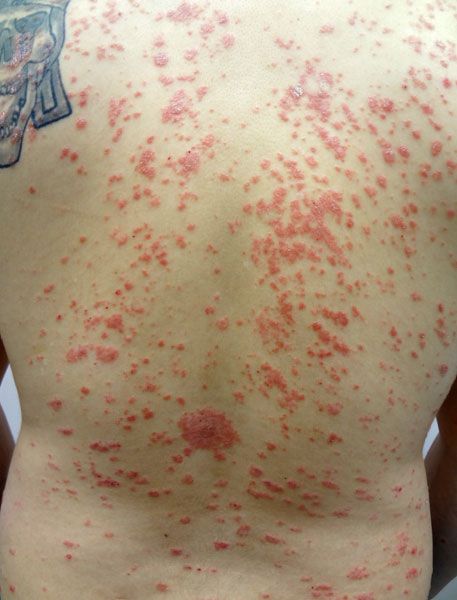
Image courtesy of Ted Rosen, MD.
Click here for the next image
A recent outbreak of small-plaque and guttate psoriasis was confined primarily to the arms of this 32-year-old woman. The slightly scaly, brick-red, linear plaques and clusters consisted of 3- to 10-mm papules, some surrounded by a faint whitish ring. Many corresponded to areas where she had been scratched by her cat. This case demonstrates 2 classic features of psoriasis: Koebner phenomenon (typical lesions at sites of skin trauma or injury, such as scratches) and Woronoff ring (an area of concentric blanching around healing psoriatic lesions). Koebner phenomenon is not specific for psoriasis and may be observed in lichen planus or contact dermatitis.
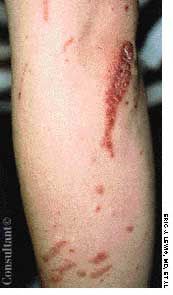
Image courtesy of Eric J. Lewis, MD and Charles E. Crutchfield, III, MD.
Click here for the next image
A 37-year-old man with chronic plaque psoriasis had been in a county jail for about 18 months where he was not exposed to sunlight and not given emollients and creams. He presented to the jail clinic with about 40% of his body affected. Physical examination revealed numerous areas of typical oval plaques with sharp, well-defined borders. Red papules that had coalesced into scales were noted. Most of the scaled areas were extremely dense, most notably on the extensor surfaces and the right anterior thigh.
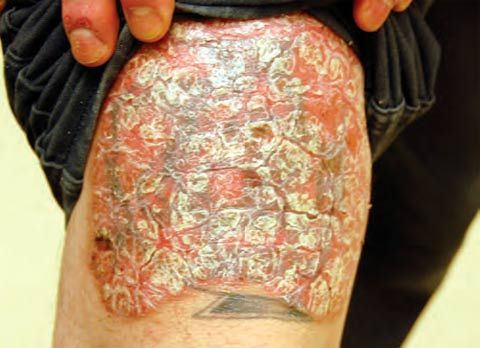
Image courtesy of Tanya Munger, MSN and Robert Bales, MD, MPH.
Click here for the next image
The most characteristic and well-known acute skin sign of systemic lupus erythematosus is the “butterfly” rash, which consists of erythematous papules and plaques in a malar distribution. Many patients with SLE have subacute cutaneous lesions that are nonscarring and do not produce atrophy. They start as erythematous papules or small plaques with scale and evolve into polycyclic plaques with central clearing or papulosquamous lesions that resemble lichen planus or psoriasis.
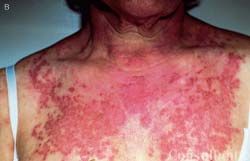
Image courtesy of Yusuf Yazici, MD, Doruk Erkan, MD, Rachelle Scott, MD, and Stephen Paget, MD.
Click here for the next image
A 48-year-old construction worker had joint pain and this worsening rash on his hands. The presence of scaly erythematous plaques, subungual hyperkeratosis, and onycholysis pointed to psoriasis, with psoriatic arthritis and dactylitis. The lesions of contact dermatitis are less well-defined than those of psoriasis, and lichen planus is less scaly. Palmar keratoderma typically is not erythematous. Rheumatoid arthritis is in the differential of psoriatic arthritis.

Image courtesy of David L. Kaplan, MD.
Click here for the next image
A 4-year-old boy presented with a generalized papulosquamous rash that reportedly began on his neck and head and then spread to his trunk. The skin on his hands and feet became thick and fissured. Psoriasis was suspected, but he had typical pityriasis rubra pilaris. A unique “sandal-like” keratoderma that develops on the hands and feet is characterized by sharp margins. The primary and characteristic skin lesions are small, follicular reddish-yellow scaling papules that coalesce into plaques that form such that islands of normal-appearing skin are left. Biopsy findings of follicular hyperkeratosis and a characteristic pattern of orthokeratosis and parakeratosis help distinguish PRP from psoriasis.
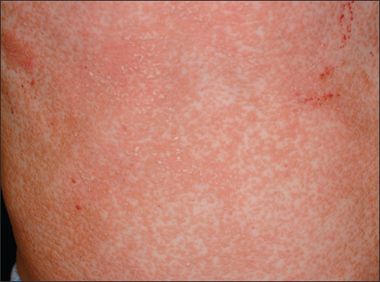
Image courtesy of Kirk Barber, MD, FRCPC.
Click here for the next image
A 76-year-old man who presented for a total body skin examination had many previous nonmelanoma skin cancers and 1 melanoma in-situ. The asymptomatic lesion depicted was discovered on his left ankle. Absent a history of papulosquamous skin disease, such as psoriasis, a solitary, well-demarcated, bright-red scaly patch should suggest superficial basal cell carcinoma or in-situ squamous cell carcinoma. In this case, a small biopsy established the correct diagnosis: squamous cell carcinoma in-situ (Bowen disease).
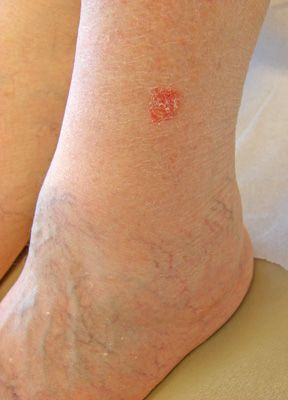
Image courtesy of Ted Rosen, MD.
Click here for the next image
This macular rash on the palms of a 24-year-old HIV-positive man is typical of secondary syphilis. Patients often first present with constitutional symptoms, such as headache, sore throat, fever, and fatigue. The GI tract, CNS, or other systems may be involved. Telltale cutaneous lesions often manifest on the palms, soles, and face; they may be papular, macular, pustular, or plaque-like. The differential diagnosis includes erythema multiforme, lichen planus, and guttate psoriasis.
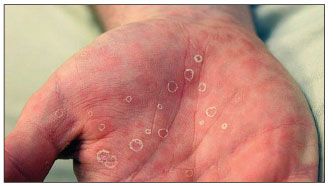
Image courtesy of David Lubin, MD.
Click here to return to the first image.
